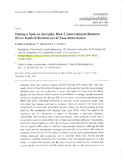| dc.description.abstract | When the Canadian company Bedford Biofuels (BB) started talks with local ranch owners in Tana Delta district (Kenya) about subleasing their land for a large jatropha plantation, they were not the first ones to come to the region for a large-scale agricultural project. Nor were they the first to explore the possibilities of starting a jatropha plantation in Kenya’s coastal area. By the time BB arrived, nature conservation and humanitarian NGOs had firmly established themselves as protectors of the ecologically fragile Tana river delta (now Ramsar site) and its residents, who were argued to be (even more) marginalized by large-scale agricultural projects. During the decision-making process, therefore, BB encountered stiff resistance from local NGOs, which had acquired the experience and the mechanisms to oppose or discourage a large-scale plantation. Additionally, BB was faced with a central government which gradually moved from a pro-jatropha stance to a more critical view of large-scale jatropha cultivation. Nevertheless, most of the local residents as well as the local government administration and the county council supported BB’s plans to establish a large jatropha plantation. Although the deal was struck and the anti-jatropha campaign had ostensibly not prevailed, BB closed its plantation within the year. In the article, we analyze how discursive generalizations about foreign large-scale land acquisitions and in particular about large foreign jatropha plantations gradually undermined the legitimacy of the BB jatropha plantation in Tana Delta. To explore this question, the discussion focuses on analyzing the resources that account for the success of the anti-BB rhetoric and the interests that were involved in its production. These resources have been identified as local to global (I)NGO alliances; the use of e-media as a conduit for opposition rhetoric and the strategic use of rhetorical images and polemic. Each of the three phenomena will be explored for their conceptual dimensions and their rhetorical implications. We argue that the conservationist rhetoric compressed intermediality, the grid where ideologies and practices of different stakeholders intersect. Thus, it effectively narrowed the possibility for non-compatible stakeholders, such as Bedford Biofuels, to avoid conflict. This initiated a gradual erosion of the rationale of the BB jatropha project in Tana Delta, which eventually led to the closure of the jatropha project and the departure of Bedford Biofuels from the area. | en_US |

